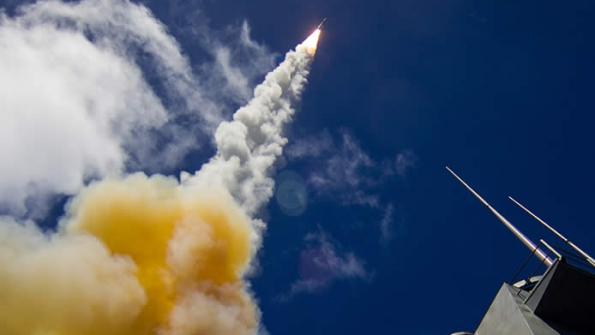
A U.S. Navy document that cryptically describes a versatile and powerful new missile likely offers the first confirmation of the hypersonic speed and newly acquired, antisurface-warfare role for the Raytheon SM-6 Block 1B.
The terse reference in a written submission by Navy officials to the House Armed Services Committee on March 11 also likely offers the first proof that the SM-6 Block 1B remains in development, even after the Navy scrubbed all references to the project in the latest round of fiscal 2021 budget documents.
Also, written testimony submitted by James Guerts, assistant Navy secretary for acquisition, offers the first confirmation of the service’s third hypersonic-weapon development program, joining the anti-air Hypervelocity Projectile in development by the Strategic Capabilities Office and the intermediate-range Conventional Prompt Strike (CPS) program.
Under a single paragraph headlined as “Hypersonics” in Guerts’ testimony, he describes the HVP and CPS—a 34.5-in.-dia., two-stage booster stack topped by a hypersonic glide vehicle—and a third, unnamed and previously undisclosed hypersonic program.
“Additional work for guidance and control as well as warhead design will yield a new capability that provides antiair-warfare capability, including cruise missile defense, in support of ships [sic] self-defense, as well as anti-surface warfare,” Guerts’ testimony states.
A Navy spokesman declined to elaborate on that description or identify the name of the program, citing security requirements.
The description, however, aligns with the known elements of the SM-6 Block 1B development program. In budget documents submitted last year for fiscal 2020, the Navy described a plan to field the SM-6 Block 1B by fiscal 2024 with a wider, 21-in.-dia. booster to increase the range and speed of the standard, Mach 3.5-class missile, but the documents did not say by how much. The fiscal 2020 budget documents also mention plans to add a new thermal protection system and update the guidance, navigation and control system for the SM-6 Block 1B.
Guerts’ testimony on March 10 is not the first to link the SM-6 Block 1B to the antisurface-warfare role. A presentation by the Navy at the Surface Warfare Association’s annual conference in January 2019 listed the SM-6 Block 1B on a chart as one of several antisurface-warfare weapons. But Guerts’ testimony adds a potentially important detail. He referenced a new “warhead design” for the new hypersonic weapon, addressing a flaw of the baseline version of the SM-6 for an anti-surface application. The warhead on the baseline SM-6 weighs only 140 lb., a mass the Congressional Budget Office cited as inadequate against a modern combat ship.






Comments
At the bottom end of hypersonic speeds (M=5) that is approx. 5500 fps. Since the USN is unlikely to offer up a ship for target practice, consider that the kinetic effects are possibly more severe than explosive ones.